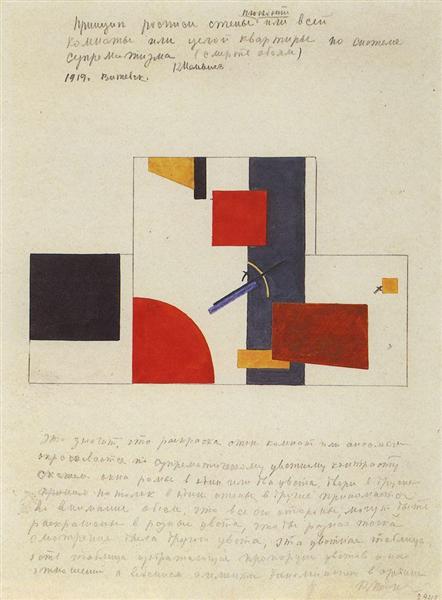Description
The principle of suprematism finds a refined manifestation in the work "The principle of painting the walls" of 1920, by Kazimir Malevich. This painting encapsulates the essential concerns and explorations of the Russian artist, who sought at all times to transcend traditional forms and approach a purest pictorial language, focused on the use of color and the form like vehicles of autonomous expression.
At first glance, the composition of the work might seem like a random collection of geometric shapes and colors, but a more detained inspection reveals a deliberate organization and a meticulous interaction between its elements. Malevich places several floating geometric figures rectangles, squares and triangles on a white background. This white space is not merely an emptiness, but an active component that highlights and contrasses colorful figures, allowing each one to breathe and maintain its individuality.
The colors used in "the principle of painting the walls" are vibrant and of great purity: red, blue, black and yellow they combine and contrast. These choice are not random; Each color has its function and place in the three -dimensionality of the canvas, creating a visual balance that is almost musical in its harmony. Malevich does not seek to represent tangible reality but a spiritual and philosophical reality; Through suprematism, it seeks to free yourself from the bonds of physical representation and enter the mastery of the absolute.
In the context of its artistic production, this work is registered within a crucial phase of Malevich's development. Having formulated the principles of suprematism around 1915, Malevich continued to deepen its exploration of the non -subjectivity of art. "The principle of painting the walls" reflects a maturity in their vision, evidencing a total commitment to geometric abstraction. Although there are no human figures in the work, the implicit presence of human action cannot be ignored, suggested in the very title of the painting. The walls, usually support surfaces for other forms of artistic expression, become the main subject of introspection and transformation by suprematist forms.
This commitment to Malevich's abstraction can also be found in other works of the same era, such as "black square" or "white on white." In these pieces, the artist takes to the extreme his speech on the purity of shape and color, inviting the viewer to contemplate not only what is present in the canvas, but what those absences and epistemological budgets tell us about our perception of our perception of art.
"The principle of painting the walls" is, in short, a work that demands a double reading: an understanding of strictly formal visual language and a meditation on the philosophical implications of the liberation of forms. Comicity, depth and a remarkable conceptual audacity converge in this painting, making him a relevant and essential example of the unrepeatable legacy of Kazimir Malevich and his contribution to modern art.
KUADROS ©, a famous paint on your wall.
Hand-made oil painting reproductions, with the quality of professional artists and the distinctive seal of KUADROS ©.
Art reproduction service with satisfaction guarantee. If you are not completely satisfied with the replica of your painting, we refund your money 100%.

